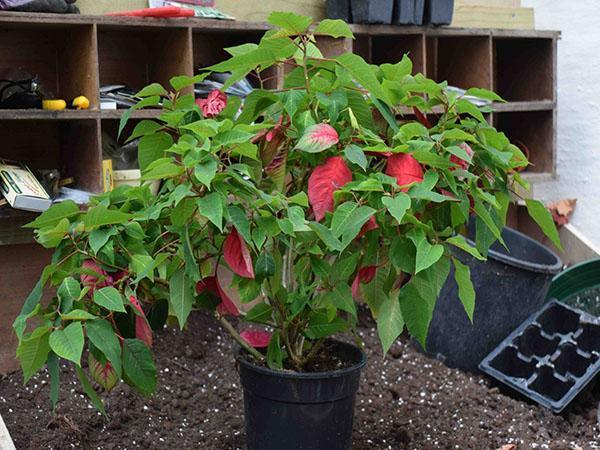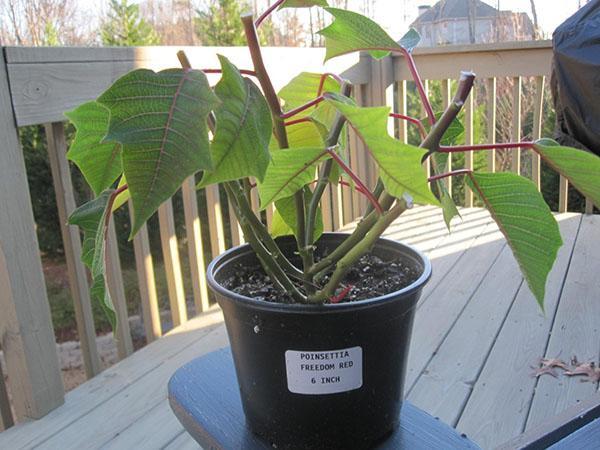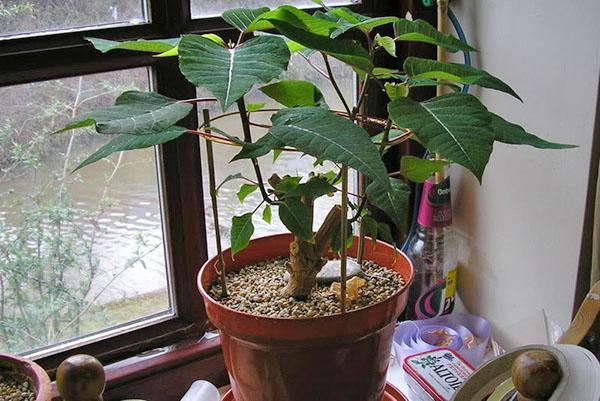Pruning and propagating poinsettia at home
 When the winter bloom of poinsettia ends, it may seem that the plant is dying, but this is not the case. Pruning and reproduction of poinsettia at home helps prolong the life of a flower. A timely and properly pruned perennial gives excellent planting material, and after rest forms young shoots and blooms profusely.
When the winter bloom of poinsettia ends, it may seem that the plant is dying, but this is not the case. Pruning and reproduction of poinsettia at home helps prolong the life of a flower. A timely and properly pruned perennial gives excellent planting material, and after rest forms young shoots and blooms profusely.
The peculiarity of poinsettia is winter flowering, accompanied by the appearance of a rosette of brightly colored bracts. Thanks to them, the plant received a second name - the Christmas star. It is not surprising that poinsettia in many countries is presented as a gift for the winter holidays. But when the flowering is over, the compact shrub loses its decorative effect.
Novice growers sometimes take the fall of the foliage as a sign of death and mercilessly get rid of the flower. Take your time!

Trimming poinsettia at home
 The first pruning of poinsettia after the purchase of the house is waiting for a flower after the bright deciduous rosettes wither. Before the plant goes to rest, it is cut off, leaving 3-5 healthy buds on each of the shoots. They will provide new growth and become the basis for future flowering. For rest, the poinsettia is transferred to a cool, dry room. At a temperature of + 14–16 ° C, under the scattered rays of the sun, the pot remains for 2 months.
The first pruning of poinsettia after the purchase of the house is waiting for a flower after the bright deciduous rosettes wither. Before the plant goes to rest, it is cut off, leaving 3-5 healthy buds on each of the shoots. They will provide new growth and become the basis for future flowering. For rest, the poinsettia is transferred to a cool, dry room. At a temperature of + 14–16 ° C, under the scattered rays of the sun, the pot remains for 2 months.
As long as there are no signs of awakening on the stems, the poinsettia needs almost no watering. If the soil is moistened, then very carefully to cause decay of the roots and aerial parts.
In May, the resting period of the punsettia ends. Left kidneys are awakening. As soon as this happens, the pot is transferred to a warm, bright room and active watering is resumed, making sure that between the procedures the top layer of the soil dries out a little, and water does not accumulate in the pan under the pot.
To make the flowering as lush and strong as possible, no more than 5-6 strong shoots should be left on the flower. In the future, the green parts of the flower can be pinched until August, when the rudiments of future inflorescences are laid at the ends of the shoots.
 Parts of the stems that have become unnecessary after pruning, when the poinsettia is propagated at home, turn into excellent cuttings.
Parts of the stems that have become unnecessary after pruning, when the poinsettia is propagated at home, turn into excellent cuttings.
Reproduction of poinsettia by cuttings
Most often, flower growers use the possibility of vegetative reproduction. Best of all, cuttings from 10 to 15 cm long, obtained after pruning the poinsettia, root at home in the spring and early summer.
Since the plant secretes milky juice, which interferes with not only drying the cut, but also root formation, then before planting the pieces of stems in the ground:
- their lower leaves are cut off;
- the places of the cuts are immersed in water for a few minutes;
- then blotted with a paper towel;
- the tips of the stems are sprinkled with a rooting stimulator.
 The cuttings intended for the poinsettia propagation are now ready for planting. A light, breathable mixture of washed sand and perlite can be used as a substrate. The root system of young plants is not too large, therefore, at first and before the poinsettia is transplanted to a permanent residence, very small pots or cups with a capacity of up to 250 ml can be used.
The cuttings intended for the poinsettia propagation are now ready for planting. A light, breathable mixture of washed sand and perlite can be used as a substrate. The root system of young plants is not too large, therefore, at first and before the poinsettia is transplanted to a permanent residence, very small pots or cups with a capacity of up to 250 ml can be used.
A drainage hole is made at the bottom of the container.The cutting is immersed in the ground to a depth of 3 cm, that's enough. The seedlings are placed in a room greenhouse. Further, young poinsettias require:
- watering as needed;
- bright but not direct light;
- constant temperature in the range of 16-22 ° C;
- regular ventilation.
This leave is sufficient to give the stem tops after 45–60 days roots and are ready to be transferred to permanent pots. For transplanting poinsettia, containers with a diameter of 7-10 cm are taken, at the bottom of which a drainage layer is made, and then filled with a substrate based on leaf and sod soil with the inclusion of a small amount peatcleaned of foreign inclusions and sand.
With the beginning of active growth, the top of the seedling is removed. This trimming of poinsettia at home allows you to immediately get a branching bush with several bright inflorescences.
 Poinsettias that have already bloomed in the previous season are transplanted in a similar way. The procedure is carried out in the second half of spring after pruning the home plant.
Poinsettias that have already bloomed in the previous season are transplanted in a similar way. The procedure is carried out in the second half of spring after pruning the home plant.
Reproduction of poinsettia semenami
Few people know that pruning is not so necessary for breeding poinsettia at home. Self-pollinating tiny flowers, you can wait for the formation and maturation of rounded, almost black seeds.
It is more convenient to transfer pollen with a cotton swab or thin soft brush. At the same time, it is important to touch each flower and make sure that the grains of fat hit the right place.
After a while, greenish seed pods appear in place of the flowers, outwardly resembling small bulbs.
 When the foliage begins to fall off, the boxes are collected and stored in a paper bag without moisture. The dried, turned brown capsules open easily, and the ripe seeds roll out.
When the foliage begins to fall off, the boxes are collected and stored in a paper bag without moisture. The dried, turned brown capsules open easily, and the ripe seeds roll out.
 To stimulate the formation of sprouts, poinsettia seeds, spread out on moistened soil and lightly sprinkled with soil, are sent to a household refrigerator for stratification for three months.
To stimulate the formation of sprouts, poinsettia seeds, spread out on moistened soil and lightly sprinkled with soil, are sent to a household refrigerator for stratification for three months.
Germination starts when it is warm and takes several weeks. All this time, crops should be moderately moistened. Mold or rot must not be allowed, so the greenhouse must be regularly ventilated.
Seedling care is little different from other home crops. Small plants first dive, and then, when they get stronger, transplant poinsettia into spacious pots.
Poinsettia diseases and pests
 Problems faced by a florist when transplanting, reproducing and pruning poinsettia at home associated with violations of the rules of care. Although this plant cannot be called moody, the flower can be attacked by insects, pathogenic fungi and dangerous bacteria.
Problems faced by a florist when transplanting, reproducing and pruning poinsettia at home associated with violations of the rules of care. Although this plant cannot be called moody, the flower can be attacked by insects, pathogenic fungi and dangerous bacteria.
Among the diseases and pests of poinsettia, the greatest harm is caused by all kinds of rot, provoked by non-compliance with the watering regime and keeping the flower in an excessively hot or excessively cold room. Infestation with fungal infections and soil pests, for example, nematodes or mealybugs, cannot be ruled out if the flower is transplanted into a substrate that has already been used and has not been disinfected. A plant in dry air is readily attacked by spider mites.
However, insects do not always lie in wait for poinsettia at home. Often, already from the manufacturer, the flower gets to the windowsill infected with whiteflies hiding on the back of the leaves.
 The fight against diseases and pests of poinsettia is to normalize the conditions of detention and treat the source of the problem with fungicides or insecticides. In this case, parts of the plant affected by the fungus should be removed, and the spoiled soil must be replaced.
The fight against diseases and pests of poinsettia is to normalize the conditions of detention and treat the source of the problem with fungicides or insecticides. In this case, parts of the plant affected by the fungus should be removed, and the spoiled soil must be replaced.
Before the New Year holidays, I bought a very beautiful young poinsettia, for only 150 rubles in Pyaterochka. Today is January 12, Old New Year! My beauty in all its splendor, now only save.Thanks for the care text, took note.